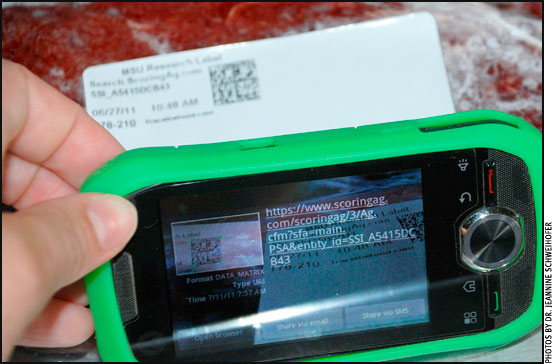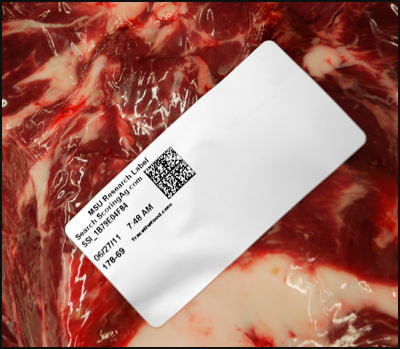 Smartphones and Steaks
Smartphones and Steaks
Unless your steak was purchased from the farmer down the road, it can be hard to tell exactly where it came from, even if the sticker on the package says local.
Thanks to a new pilot program being conducted at Michigan State University (MSU), the day may soon be approaching where a quick barcode scan with a smartphone could tell the exact animal and farm where the steak originated.
In 2007, Michigan adopted a mandatory livestock tracing program — the only one of its kind in the nation — requiring that all cattle have a radio frequency identification (RFID) ear tag before leaving their original farm. The tags are designed to track the movement of Michigan's cattle herd and provide animal health officials with a tool to trace an individual animal back to where it was born. Now that the mandatory tracking system has been in place for four years, MSU researchers want to continue improving the system by continuing the traceability of information beyond just the processor.

"By translating RFID ear tags to a barcode, pieces or packages of beef can be labeled with that code, tracing it back to the farm and the individual animal," says Dan Buskirk, MSU animal science professor.
"We want to be able to trace individual animals from the farm to the plate," said MSU animal science associate professor Dan Buskirk. "By translating RFID ear tags to a barcode, pieces or packages of beef can be labeled with that code, tracing it back to the farm and the individual animal."
Buskirk, who has been working with the Michigan RFID program since its inception, was looking for a way to expand its value when fellow animal science assistant professor Jason Rowntree began working on a new project to utilize MSU-raised beef cattle in MSU restaurants and cafeterias. It quickly became clear that MSU Culinary Services was interested in not only locally sourced beef, but also the potential for full traceability of beef from the farm to the plate.
"There is not a commonly accepted definition for the word 'local,'" he added. "What we're trying to do is to be able to not only say it's local, but to prove it's local."
The pilot for the local beef project will also serve as the pilot program for Buskirk and his team to begin putting the pieces in place to track beef all the way to the consumer. He is working with small- and medium-sized food processors to perfect the technology and identify any challenges for implementing it. Coordinating the barcode with the multitude of products that can come from a single animal appears to be one of the biggest hurdles they face.
The researchers hope consumers will be able to scan the barcode at a kiosk in the grocery store or by using a smartphone application (app). The code would then link the consumer to information about the farm of origin, its management practices and similar types of information.
Consumers won't be the only ones benefitting.
"Smaller (livestock) producers have done a lot of good things in terms of beef quality assurance, developing and adopting cutting-edge production methods and observing really good solid management practices, but they don't have a good way, necessarily, to let consumers know about this unless they're marketing beef directly to a consumer as freezer beef or marketing it at a local farmers market," Buskirk said.
 The pilot program would allow consumers an opportunity to know exactly what farming practices were used and how the animal was raised, he concluded.
The pilot program would allow consumers an opportunity to know exactly what farming practices were used and how the animal was raised, he concluded.










